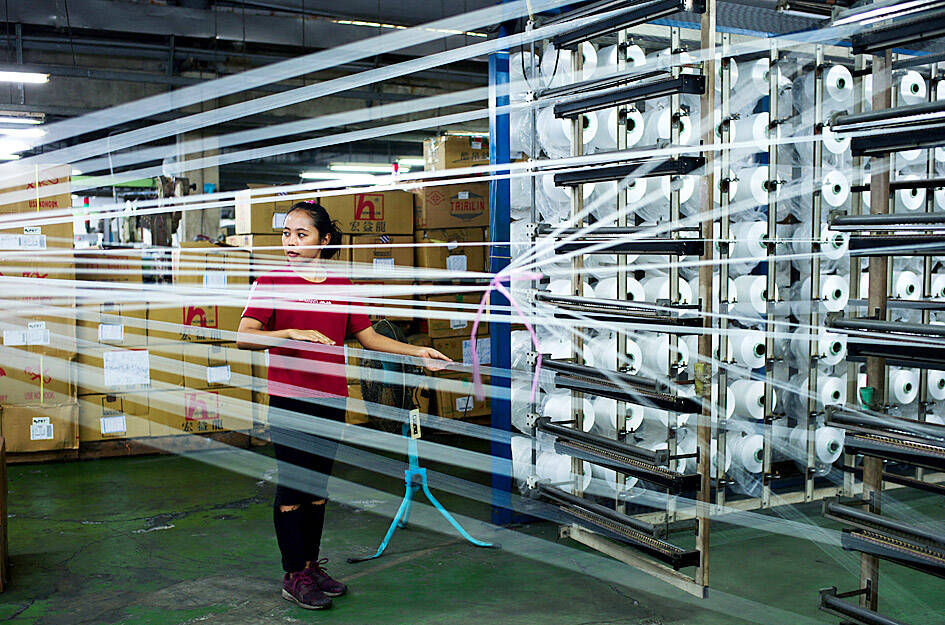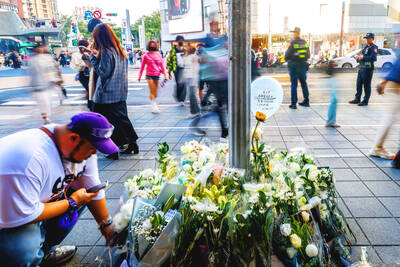Growing up on Taiwan’s west coast where mollusk farming is popular, Eddie Wang saw discarded oyster shells transformed from waste to function — a memory that inspired him to create a unique and environmentally friendly fabric called “Seawool.”
Wang remembered that residents of his seaside hometown of Yunlin County used discarded oyster shells that littered the streets during the harvest as insulation for their homes.
“They burned the shells and painted the residue on the walls. The houses then became warm in the winter and cool in the summer,” the 42-year-old said at his factory in Tainan.

Photo: Sam Yeh, AFP
“So I was curious about why oyster shells have such a miraculous effect,” he said.
Wang’s Creative Tech Textile company, established in 2010, was already producing an “eco-fabric” — a polyester material made out of recycled plastic bottles — but he felt its texture was a bit “ordinary.”
He started working with a research institute to experiment with making fabric out of oyster shell residue, in 2013 coming up with the right formula that produces a material similar to wool.
Today, his factory in Taiwan uses about 100 tonnes of oyster shells a year to churn out about 900 tonnes of Seawool, a trademarked and patented fabric.
The fabric and clothing generate about NT$200 million (US$6.24 million) a year, with the bulk of it sourced by outdoor and sustainability clothing brands in Europe and the US.
The fabric made in Taiwan would not be possible without the nation’s unique oyster farming culture, Wang said.
“This industry chain cannot be found anywhere else overseas,” he said. “We have people to harvest oysters, we have specialists to clean oyster shells, and we have people for drying and calcining [treating] oyster shells.”
Taiwan has a hefty appetite for oysters, harvesting an estimated 200,000 tonnes a year with the fleshy meat used in local cuisine such as crispy omelets and silk-like noodle dishes.
However, its popularity also means that about 160,000 tonnes of shells are discarded yearly, according to data from the Ministry of Agriculture.
They pile up on the streets of aqua-farming towns — the majority in western cities such as Yunlin, Changhua and Chiayi — causing environmental issues by emitting fishy smells and providing breeding sites for mosquitos.
At Wang’s factory, the shells are ground into nano beads and combined with yarn made from recycled plastic bottles.
“It creates a magical yarn,” he said. “Oyster shell is a material with low thermal conductivity — it does not absorb heat, nor does it dissipate heat.”
Turning the shells — which capture and store carbon dioxide from the atmosphere — into Seawool also does not require water, making it a “low-carbon product,” Wang said.
A half-hour drive from his showroom where activewear jackets, sweaters and pants are displayed, state enterprise Taiwan Sugar Corp (TSC) also has a factory that grinds discarded shells into a powder used in manufacturing household items such as incense sticks.
The crushed shells help to reduce smoke and the toxic chemicals emitted from burning incense, said Chen Wei-jen, deputy chief of TSC’s biotech business division.
“We hope oyster shells can have multiple industrial applications and interested companies can use it as a raw material to make their products more environmentally friendly and add value to their products,” Chen said.
Before the shells get to the factories, farmers in Chiayi County — famed for producing oysters — collect the mollusks at dawn from racks installed along the coast. They are sorted into baskets before being sent to plants such as Dai Sen-tai’s factory, where they are machine-washed before being sent to small family-run businesses that shuck the meat and send the shells south.
Dai, whose family has been in the oyster farming industry for three generations, said he is happy that Taiwan is breathing new life into the sea waste.
“When I was a child, no one wanted oyster shells — they were dumped and discarded everywhere,” he said. “It’s good that the waste has been turned into gold now.”

SHIPS, TRAINS AND AUTOMOBILES: The ministry has announced changes to varied transportation industries taking effect soon, with a number of effects for passengers Beginning next month, the post office is canceling signature upon delivery and written inquiry services for international registered small packets in accordance with the new policy of the Universal Postal Union, the Ministry of Transportation and Communications said yesterday. The new policy does not apply to packets that are to be delivered to China, the ministry said. Senders of international registered small packets would receive a NT$10 rebate on postage if the packets are sent from Jan. 1 to March 31, it added. The ministry said that three other policies are also scheduled to take effect next month. International cruise ship operators

NUMBERS IMBALANCE: More than 4 million Taiwanese have visited China this year, while only about half a million Chinese have visited here Beijing has yet to respond to Taiwan’s requests for negotiation over matters related to the recovery of cross-strait tourism, the Tourism Administration said yesterday. Taiwan’s tourism authority issued the statement after Chinese-language daily the China Times reported yesterday that the government’s policy of banning group tours to China does not stop Taiwanese from visiting the country. As of October, more than 4.2 million had traveled to China this year, exceeding last year. Beijing estimated the number of Taiwanese tourists in China could reach 4.5 million this year. By contrast, only 500,000 Chinese tourists are expected in Taiwan, the report said. The report

HORROR STORIES: One victim recounted not realizing they had been stabbed and seeing people bleeding, while another recalled breaking down in tears after fleeing A man on Friday died after he tried to fight the knife-wielding suspect who went on a stabbing spree near two of Taipei’s busiest metro stations, Taipei Mayor Chiang Wan-an (蔣萬安) said. The 57-year-old man, identified by his family name, Yu (余), encountered the suspect at Exit M7 of Taipei Main Station and immediately tried to stop him, but was fatally wounded and later died, Chiang said, calling the incident “heartbreaking.” Yu’s family would receive at least NT$5 million (US$158,584) in compensation through the Taipei Rapid Transit Corp’s (TRTC) insurance coverage, he said after convening an emergency security response meeting yesterday morning. National

The Forestry and Nature Conservation Agency yesterday launched a gift box to market honey “certified by a Formosan black bear” in appreciation of a beekeeper’s amicable interaction with a honey-thieving bear. Beekeeper Chih Ming-chen (池明鎮) in January inspected his bee farm in Hualien County’s Jhuosi Township (卓溪) and found that more than 20 beehives had been destroyed and many hives were eaten, with bear droppings and paw prints near the destroyed hives, the agency said. Chih returned to the farm to move the remaining beehives away that evening when he encountered a Formosan black bear only 20m away, the agency said. The bear